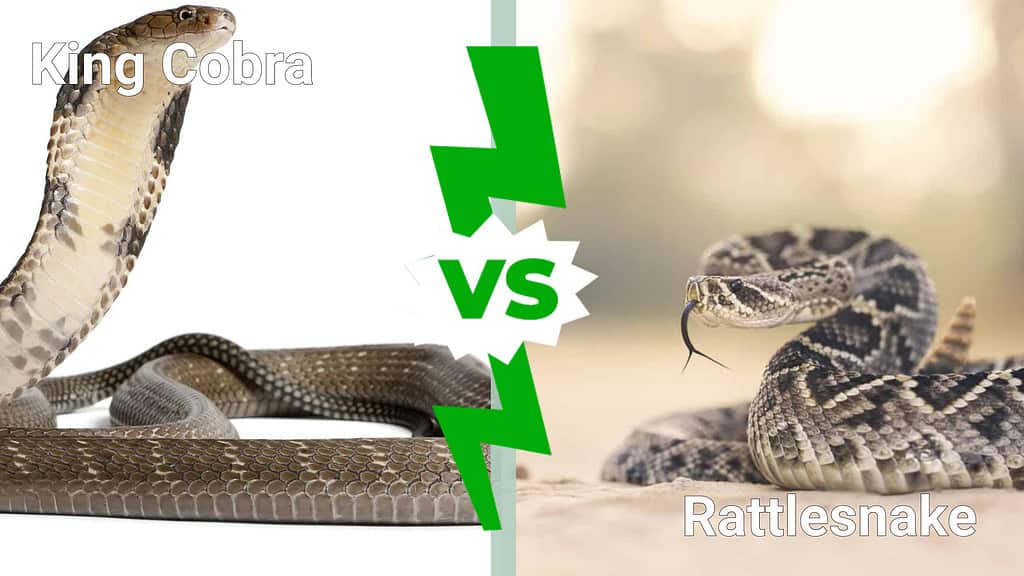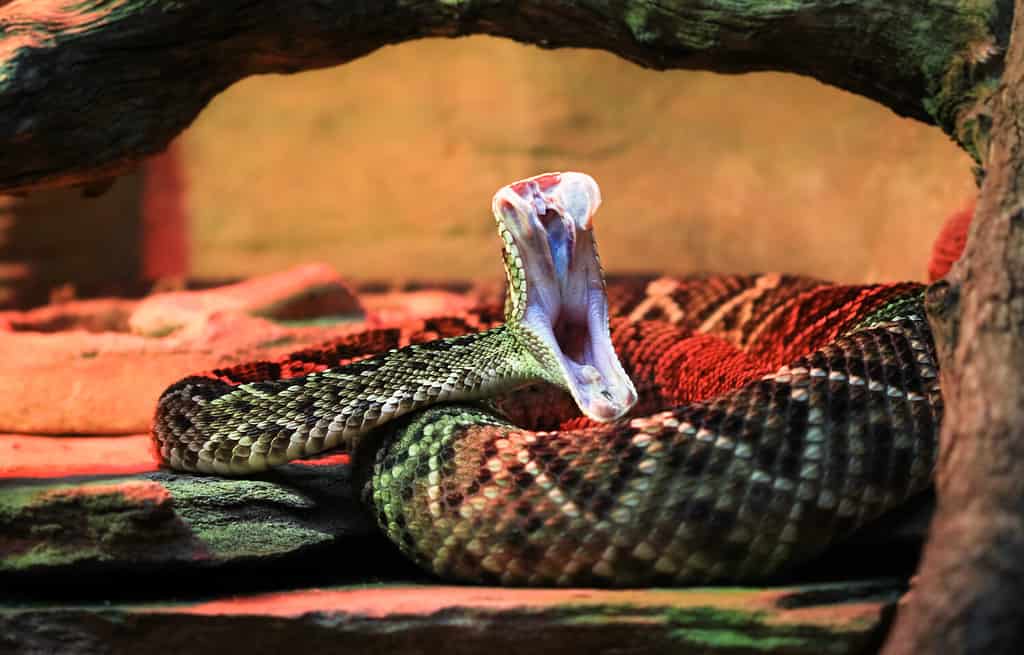A king cobra vs. a rattlesnake in a fight? Who would win this epic, imaginary battle? We examined these fearsome predators’ physical characteristics, predatory behavior, and overall lifestyles to find out.
Found in Southeast Asia, king cobras are the longest venomous snake in the world. They can grow up to 18.5 feet long, and their hiss sounds more like a growl. This species, the only one in the Ophiophagus genus, is a special sort of snake whose favorite foods aren’t rats and mice but other snakes. It is the apex predator of nearly all other snakes in its native range.
Yet, how would it fare against one of North America’s most well-known and highly evolved snakes? Based on genetic and evolutionary evidence, scientists believe rattlesnakes evolved more recently than other venomous snakes. In addition to their unique early warning system, rattlesnakes have hinged fangs and huge venom glands, which make them formidable foes.
Curious yet?
Let’s explore whether a king cobra or a rattlesnake would win a fight.
Comparing a King Cobra and a Rattlesnake

| King Cobra | Rattlesnake | |
|---|---|---|
| Size | Average 10-13 feet long up to a maximum of almost 19 | Depends on species: The smallest rattlesnakes are about 2 feet long up to almost 8 for eastern diamondbacks |
| Speed & Movement Type | Serpentine slithering up to 10 miles per hour in sprints | Serpentine or sidewinding, depending on species; usually only about 2 miles per hours |
| Defenses | Speed, strength, camouflage, and extremely toxic venom | Long fangs and sometimes massive venom quantities; excellent camouflage to stay hidden |
| Offensive Capabilities | Quick strike and neurotoxic venom; strong sense of smell and excellent vision | Quick strike and element of surprise with camouflage; strong sense of smell and heat-sensing pits |
| Predatory Behavior | Quick strike an element of surprise with camouflage; strong sense of smell and heat-sensing pits | Ambush predator that waits for prey to come close enough to strike. |
Key Differences Between a King Cobra and a Rattlesnake
There are many differences between king cobras and rattlesnakes, including location! King cobras and rattlesnakes would never naturally encounter one another because they live on opposite sides of the world: one is a subtropical species, and the other is at home in locations from temperate forests to the driest deserts.
The biggest differences between king cobras and rattlesnakes are their hunting behavior and size because they are significantly bigger than rattlesnakes and hunt during the day.

King cobras eat other snakes, and some are venomous.
©Mufti Adi Utomo/Shutterstock.com
Key Factors in a Fight Between a King Cobra and a Rattlesnake
In our imaginary fight between a king cobra and a rattlesnake, we looked at a few different rattlesnake species. Some, like the tiger and Mojave rattlesnakes, are smaller but with the most toxic rattlesnake venom. On the other end of the spectrum are the eastern and western diamondback rattlesnakes that are big and can inject massive quantities of venom.
King Cobra vs. Rattlesnake: Size & Weight
However you look at it, an adult king cobra completely outclasses any rattlesnake species. These enormous snake-eating snakes average 10 to 13 feet long and can reach lengths of 18.5 feet, and weigh up to 20 pounds.
On the other hand, the biggest rattlesnake is no slouch — an eastern diamondback rattler can measure nearly feet long and weigh 34 pounds or more. The smaller tiger and Mojave rattlesnakes will only grow to roughly three feet long and weigh about a pound.
King Cobra vs. Rattlesnake: Speed & Movement
Here again, in a king cobra vs. rattlesnake fight, the adult king cobra has the advantage. Rattlesnakes don’t move very fast. When threatened, they coil in an S shape and move backward while rattling and hissing.
In contrast, king cobras are fairly fast on the ground and in the trees. While hunting, they slither through the underbrush and up into the trees, which is why another, older name for them is hamadryad.
Both animals use a slithering motion to get from one place to the next, and both use stealth.
King Cobra vs. Rattlesnake: Defenses
A rattlesnake’s first line of defense is camouflage, which is also true for the king cobra. However, we’re hypothesizing a battle, so let’s look at their face-to-face defenses.
Both dangerously venomous snakes use their best offense as a defense: their fangs and venom. However, since the rattlesnake’s fangs are so much longer than those of the king cobra, the rattlesnake may have an advantage here. They can inject massive venom quantities much more deeply, possibly affecting the king cobra fast enough for the win.
Unfortunately for rattlesnakes hoping for the win, king cobras have a special venom-canceling protein in their blood that reduces the damage caused by venomous snakebites. This means they aren’t immune to venom, just more resistant.
This protein works especially well against the neurotoxic compounds found in the Naja genus cobras — one of the snake groups king cobras actively hunt. Does this special blood feature give king cobras the advantage? Possibly. It may offer more protection against a tiger or Mojave rattlesnake bite because their venom often contains neurotoxins.
In contrast, a rattlesnake like an eastern diamondback usually contains hemotoxins. So, if it gets in a good bite, the king cobra could have trouble. Additionally, although the eastern diamondback rattlesnake is shorter, it is powerful and stocky — really big individuals can weigh more than a big king cobra.

Eastern diamondback rattlesnakes can weigh more than a king cobra, but they’re much shorter.
©Kevin Wells Photography/Shutterstock.com
King Cobra vs. Rattlesnake: Offensive Capabilities
Here, the king cobra again has the advantage. This huge venomous snake has excellent eyesight and a great sense of smell, which it uses to its advantage.
Rattlesnakes have a fantastic sense of smell and those amazing heat-sensing pits, but their pits are next to useless against a cold-blooded predator like the king cobra. In addition, rattlesnakes aren’t known for their vision — it’s pretty weak compared to other snake species.
King Cobra vs. Rattlesnake: Predatory Behavior
Finally, predatory behavior.
Rattlesnakes can actively hunt but prefer camouflage to ambush prey when it wanders too close. These predators are more active at night, especially during the summer. However, they can be active any time during the day or night if the weather is right.
On the other hand, king cobras are active daytime hunters. They don’t have heat-sensing pits like the rattlesnakes, but they don’t need them. These apex predators are masters of hunting snakes, and the only adult snakes they can’t eat are Burmese and reticulated pythons. Their eyesight is excellent, and combined with their strong sense of smell, make king cobras the perfect predator.
King cobras make their living by eating other snakes, and their active hunting style reflects it. Many venomous snakes that eat other snakes tend to bite and hold on — making a chewing motion. This particular behavior makes people think they need to chew to envenomate. It’s a myth! Scientists believe king cobras chew to prevent escape.
King Cobra vs. Rattlesnake: Which Snake Wins in a Fight?
It doesn’t matter whether it’s a huge eastern diamondback rattler or a small but deadly tiger rattlesnake. The king cobra is perfectly adapted for its prey: other snakes. In this epic throw-down, there’s no way for a rattlesnake to win against a king cobra. Rattlers are food for nearly everything bigger, including kingsnakes and indigo snakes — both native to areas rattlesnakes occur.
In a fight between a king cobra and a rattlesnake, the king cobra will win.
The photo featured at the top of this post is ©
Discover the "Monster" Snake 5X Bigger than an Anaconda
Every day A-Z Animals sends out some of the most incredible facts in the world from our free newsletter. Want to discover the 10 most beautiful snakes in the world, a "snake island" where you're never more than 3 feet from danger, or a "monster" snake 5X larger than an anaconda? Then sign up right now and you'll start receiving our daily newsletter absolutely free.
Thank you for reading! Have some feedback for us? Contact the AZ Animals editorial team.







